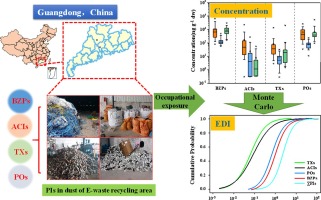当前位置:
X-MOL 学术
›
Environ. Int.
›
论文详情
Our official English website, www.x-mol.net, welcomes your
feedback! (Note: you will need to create a separate account there.)
Occurrence of multiple classes of emerging photoinitiators in indoor dust from E-waste recycling facilities and adjacent communities in South China and implications for human exposure.
Environment International ( IF 10.3 ) Pub Date : 2020-01-07 , DOI: 10.1016/j.envint.2020.105462 Juan Li 1 , Wenzheng Li 1 , Xiaoming Gao 2 , Liangying Liu 1 , Mingjie Shen 1 , Hui Chen 1 , Mingshan Zhu 1 , Lixi Zeng 1 , Eddy Y Zeng 1
Environment International ( IF 10.3 ) Pub Date : 2020-01-07 , DOI: 10.1016/j.envint.2020.105462 Juan Li 1 , Wenzheng Li 1 , Xiaoming Gao 2 , Liangying Liu 1 , Mingjie Shen 1 , Hui Chen 1 , Mingshan Zhu 1 , Lixi Zeng 1 , Eddy Y Zeng 1
Affiliation

|
Photoinitiators (PIs) are indispensable additives in photopolymerization. PI-containing consumables, such as adhesives, coatings, UV-cured inks and light-sensitive materials, are widely used in various electronic products. Nevertheless, there is no information concerning the identification of PIs as emerging contaminants from e-waste recycling. In this study, 25 PIs, including 9 benzophenones (BZPs), 8 amine coinitiators (ACIs), 4 thioxanthones (TXs) and 4 phosphine oxides (POs), were analyzed in indoor dust from typical e-waste recycling facilities and adjacent rural communities, as well as from control urban communities. All 25 target PIs were detected in e-waste dust, while only 17 and 15 of the 25 target PIs were detected in local home dust and urban home dust, respectively. The PIs detected in all dust samples were dominated by BZPs and POs, followed by ACIs and TXs. Most PIs exhibited significantly higher levels in e-waste dust than local or urban home dust. The influence of PI contamination on the local household environment by dust diffusion and transport from near e-waste recycling facilities may be lower due to the low volatility of most PIs. Characteristic composition profiles of PIs for indoor dust from the e-waste recycling area were identified and compared to those from the control area. Significant correlations were found among almost all the frequently detected PIs in the e-waste dust, indicating their similar application in electronic products and common emission from e-waste recycling. The estimated daily intakes of PIs via dust ingestion for the e-waste dismantling workers, as determined by using Monte Carlo analysis, were several times higher than those for the local adult residents and the general urban adult residents, which should be an emerging concern. To the best of our knowledge, this is the first report showing that e-waste dismantling/recycling activities lead to largely common releases of a wide range of multiple classes of PIs.
中文翻译:

在华南电子废物回收设施和邻近社区的室内灰尘中,出现了多种新兴的光引发剂,并对人体产生了影响。
光引发剂(PI)是光聚合中必不可少的添加剂。含PI的耗材,例如粘合剂,涂料,UV固化油墨和光敏材料,已广泛用于各种电子产品中。但是,没有关于将PI识别为来自电子废物回收的新兴污染物的信息。在这项研究中,分析了来自典型电子废物回收设施和邻近农村社区的室内尘埃中的25种PI,包括9种二苯甲酮(BZP),8种胺共引发剂(ACI),4种噻吨酮(TX)和4种氧化膦(PO)。以及来自控制城市社区的信息。在电子垃圾中检测到所有25个目标PI,而在25个目标PI中分别仅检测到17个和15个局部PI和城市家庭尘埃。在所有粉尘样品中检测到的PI均以BZP和PO为主,其次是ACI和TX。大多数效绩指标显示的电子废物粉尘水平显着高于本地或城市家庭粉尘。由于大多数PI的挥发性较低,粉尘的扩散和来自附近电子废物回收设施的运输对PI污染对当地家庭环境的影响可能较小。确定了来自电子废物回收区的室内灰尘的PI的特征成分图,并将其与控制区的PI进行了比较。在电子废物粉尘中几乎所有经常检测到的PI之间发现显着相关性,表明它们在电子产品中的相似应用以及电子废物回收中的常见排放。使用蒙特卡洛分析确定的,通过电子垃圾拆解工人的灰尘摄入估算的PI的每日摄入量,是当地成年人和普通城市成年人的几倍,这应该引起人们的关注。据我们所知,这是第一份报告,显示电子废物的拆解/回收活动导致多种类别的PI的广泛发行。
更新日期:2020-01-08
中文翻译:

在华南电子废物回收设施和邻近社区的室内灰尘中,出现了多种新兴的光引发剂,并对人体产生了影响。
光引发剂(PI)是光聚合中必不可少的添加剂。含PI的耗材,例如粘合剂,涂料,UV固化油墨和光敏材料,已广泛用于各种电子产品中。但是,没有关于将PI识别为来自电子废物回收的新兴污染物的信息。在这项研究中,分析了来自典型电子废物回收设施和邻近农村社区的室内尘埃中的25种PI,包括9种二苯甲酮(BZP),8种胺共引发剂(ACI),4种噻吨酮(TX)和4种氧化膦(PO)。以及来自控制城市社区的信息。在电子垃圾中检测到所有25个目标PI,而在25个目标PI中分别仅检测到17个和15个局部PI和城市家庭尘埃。在所有粉尘样品中检测到的PI均以BZP和PO为主,其次是ACI和TX。大多数效绩指标显示的电子废物粉尘水平显着高于本地或城市家庭粉尘。由于大多数PI的挥发性较低,粉尘的扩散和来自附近电子废物回收设施的运输对PI污染对当地家庭环境的影响可能较小。确定了来自电子废物回收区的室内灰尘的PI的特征成分图,并将其与控制区的PI进行了比较。在电子废物粉尘中几乎所有经常检测到的PI之间发现显着相关性,表明它们在电子产品中的相似应用以及电子废物回收中的常见排放。使用蒙特卡洛分析确定的,通过电子垃圾拆解工人的灰尘摄入估算的PI的每日摄入量,是当地成年人和普通城市成年人的几倍,这应该引起人们的关注。据我们所知,这是第一份报告,显示电子废物的拆解/回收活动导致多种类别的PI的广泛发行。











































 京公网安备 11010802027423号
京公网安备 11010802027423号